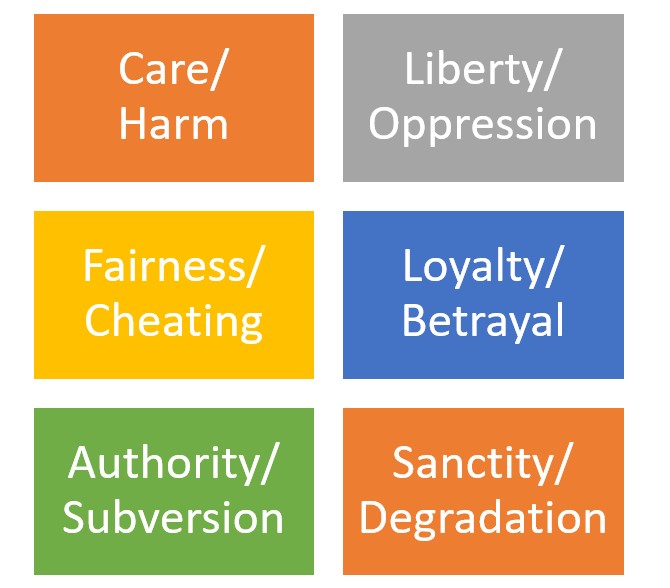Jonathan Haidt believes he can bring people of different political approaches together. To do this it is important to understand the dimensions of morality.
Understanding Others
Haidt’s is an admirable goal. He is surely right when he notes that differences are not simply because “some people are good and others evil” (Haidt, 2012, page 370).
He has developed a new way of looking at the way people think about morality. This is important if you are interested in decision-making. He suggests that liberals (in the US sense) use a smaller number of dimensions for moral judgments than conservatives.
Six Dimensions of Morality
The six dimensions his extensive research has identified are:
- 1) Care/Harm
- 2) Liberty/Oppression
- 3) Fairness/Cheating
- 4) Loyalty/Betrayal
- 5) Authority/Subversion
- 6) Sanctity/Degradation
I have a slight confusion with his work and am unsure that his quest will succeed to bring people together. Basically, I’m not sure what the relationship between the dimensions is supposed to be.
Haidt seems to suggest that conservatives see all six dimensions as worthy goals. They all make sense in themselves. If this is the case it is a problem. When people think fundamentally differently how can the different political approaches be united? The conservatives will say that authority is an important goal in itself. The liberals will say it isn’t. There isn’t much to discuss.
Preserving those institutions and traditions is their [Conservatives] most sacred value.
Haidt, 2012, page 357
If a tradition seems to harm people liberals will want to get rid of it. The conservatives may believe it is worth preserving despite the harm. To them, you balance the harm with the need for tradition.
Did I Get It?
At other times it seemed possible that Haidt is suggesting something different. Conservatives worry about traditions for a slightly different reason. They don’t worry about the tradition per se. They worry that the change can “…even hurt the very victims liberals were trying to help”, (Haidt 2012, page 361).
This is quite different. In this view defending traditions is not a good thing in itself. Instead, it is a way of helping people given that traditions allow us to effectively run society. This makes a lot more sense to me than worrying about a tradition itself.
How Does Tradition Work?
Conservatives might not totally understand how traditions help people. Still, they believe traditions do. Their existence is evidence that they work, therefore, we should protect traditions. This view is more hopeful for bringing people together. We can improve our knowledge of how the world works. When we do that we can explain to liberals which traditions really do help. Then we need to work on preserving these traditions. We can then explain to conservatives which traditions don’t work. Hence which traditions we can happily get rid of them.
Haidt’s work is interesting. I’m still confused but I’m looking forward to hearing more.
For more from Jonathan Haidt see here.
Read: Jonathan Haidt (2012) The Righteous Mind: Why Good People Are Divided By Politics and Religion, Vintage Books

